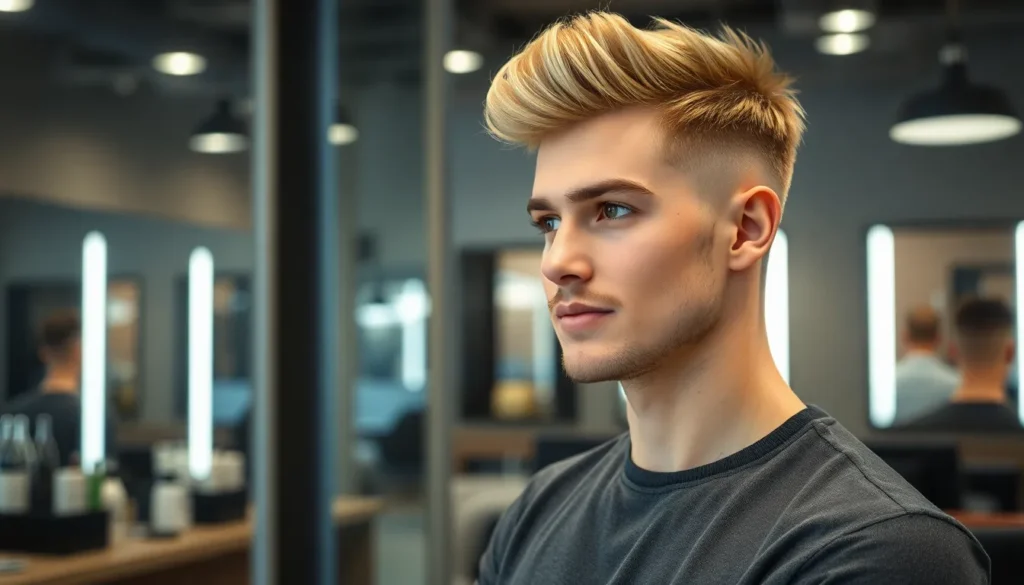We’ve all seen the dramatic transformation that highlights can bring to men’s hair – from subtle sun-kissed effects to bold statement looks that turn heads. Men’s highlights aren’t just a trend anymore; they’re a powerful styling tool that’s reshaping how we think about masculine grooming and self-expression.
Whether you’re looking to add dimension to flat hair, cover emerging gray strands, or simply experiment with a fresh new look, highlights offer endless possibilities. From natural-looking foils that mimic beach-bleached hair to edgy platinum streaks that make a statement, there’s a highlighting technique for every personality and lifestyle.
We’re here to guide you through everything you need to know about men’s highlights – the different techniques, maintenance requirements, and how to choose the perfect shade for your skin tone and hair type. Let’s explore how this versatile coloring method can elevate your style game.
What Are Mens Highlights and Why They’re Trending
Mens highlights involve strategically lightening select strands of hair to create contrast and depth throughout the overall look. This coloring technique adds dimension by introducing lighter tones that complement the base hair color rather than completely changing it. Professional stylists use various methods like foils, caps, or balayage to achieve these targeted color effects.
The trending nature of mens highlights stems from several cultural and practical factors we’ve observed in recent years. Social media platforms showcase male celebrities and influencers sporting highlighted looks, making this style more mainstream and acceptable. Men increasingly embrace grooming practices that were once considered exclusively feminine, leading to greater experimentation with hair color.
Professional environments have also become more accepting of creative hair choices, allowing men to express their personal style without career concerns. The versatility of highlighting techniques means guys can choose subtle sun kissed effects for conservative workplaces or bold contrast streaks for creative industries. This flexibility appeals to men seeking personalized looks that match their lifestyle demands.
Hair health benefits drive another reason for the popularity surge we’re witnessing. Strategic highlighting can camouflage thinning areas by creating visual texture and movement throughout the hair. Graying hair becomes less noticeable when blended with professionally applied highlights that match natural color variations.
The maintenance aspect attracts busy professionals who want updated looks without frequent salon visits. Well placed highlights grow out gradually and naturally, requiring touch ups every 8 to 12 weeks instead of monthly appointments. This practical timeline fits better with masculine grooming routines that prioritize efficiency and long lasting results.
Classic Foil Highlights for a Timeless Look
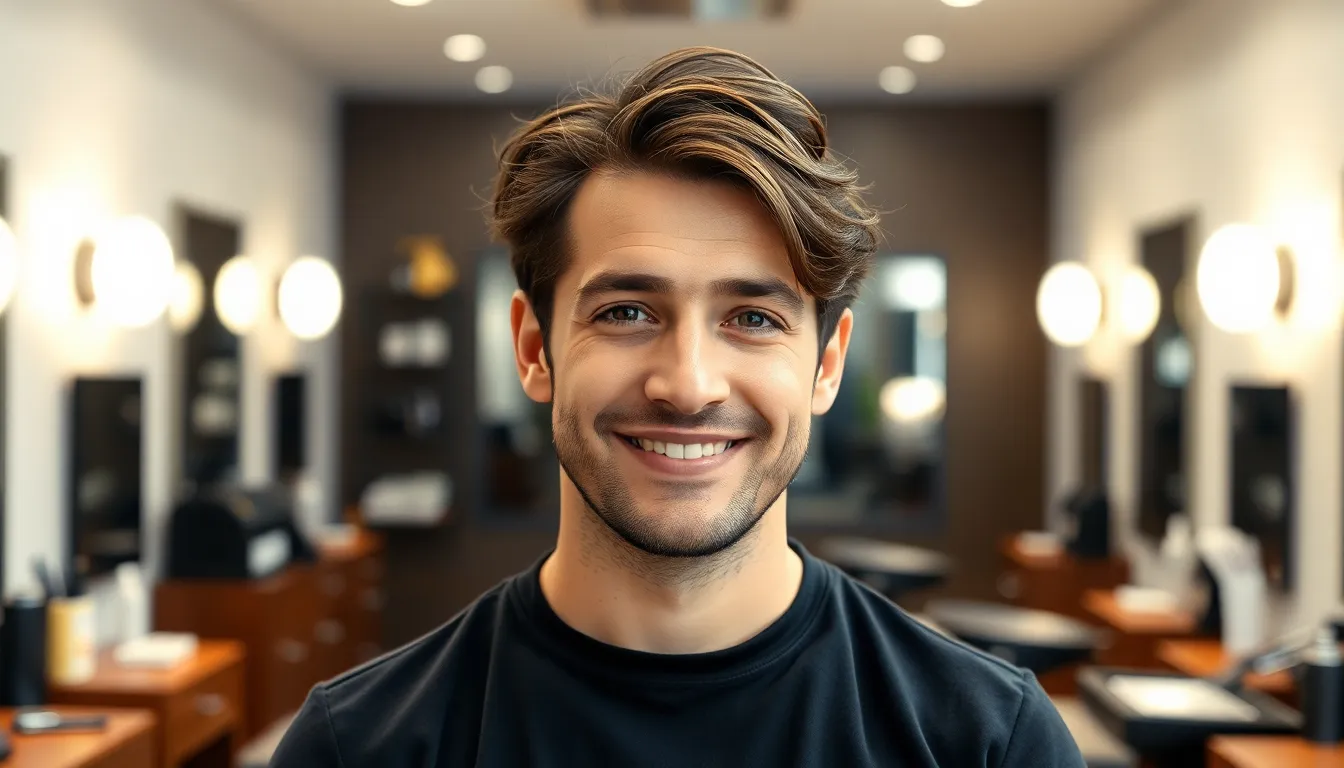
Foil highlights remain the gold standard for men seeking sophisticated hair color that enhances their natural features. We’ll explore the most enduring highlight styles that deliver professional results and versatile appeal.
Traditional Blonde Highlights
Traditional blonde highlights offer the most dramatic contrast for men with darker base colors. We recommend choosing shades that are 2-3 levels lighter than your natural hair to create noticeable dimension without appearing artificial.
Popular blonde highlight options include:
- Ash blonde for cool undertones
- Golden blonde for warm skin tones
- Platinum blonde for bold statements
- Dirty blonde for subtle enhancement
Men with brown or black hair achieve the most striking results with blonde foils placed strategically around the face and crown. Professional colorists use varying widths of foil sections to create natural looking movement throughout the hair.
Blonde highlights require more maintenance than other options, typically needing touch ups every 6-8 weeks to prevent visible roots. The lightening process may take multiple sessions for darker hair colors to reach the desired blonde shade safely.
Subtle Brown Highlights
Subtle brown highlights provide natural looking dimension without dramatic color changes. We suggest choosing brown tones that are 1-2 shades lighter than your base color for the most believable results.
Effective brown highlight combinations:
- Light brown on medium brown hair
- Chestnut on dark brown hair
- Mocha on black hair
- Chocolate on auburn hair
Brown highlights blend seamlessly with natural hair growth, making them ideal for men who prefer low maintenance color. The subtle contrast adds depth and texture while maintaining a professional appearance suitable for conservative work environments.
These highlights work particularly well for men experiencing early graying, as the lighter brown tones help camouflage gray strands naturally. Touch ups are typically needed every 10-12 weeks due to the gradual color fade.
Caramel and Honey Tones
Caramel and honey highlights create warm, sun kissed effects that complement most skin tones. We find these colors particularly flattering for men with olive or warm undertoned complexions.
Popular warm highlight shades:
- Deep caramel for rich contrast
- Golden honey for natural warmth
- Butterscotch for subtle brightness
- Amber for sophisticated depth
Caramel tones work exceptionally well as partial highlights focused on the top layers of hair. Honey shades create beautiful dimension when woven throughout medium to dark brown hair using fine foil sections.
These warm highlights develop beautifully over time, often appearing more natural as they fade slightly between appointments. Men appreciate how caramel and honey tones enhance their hair’s natural movement and create the appearance of thicker, fuller hair through strategic color placement.
Modern Balayage Highlights for Natural Dimension
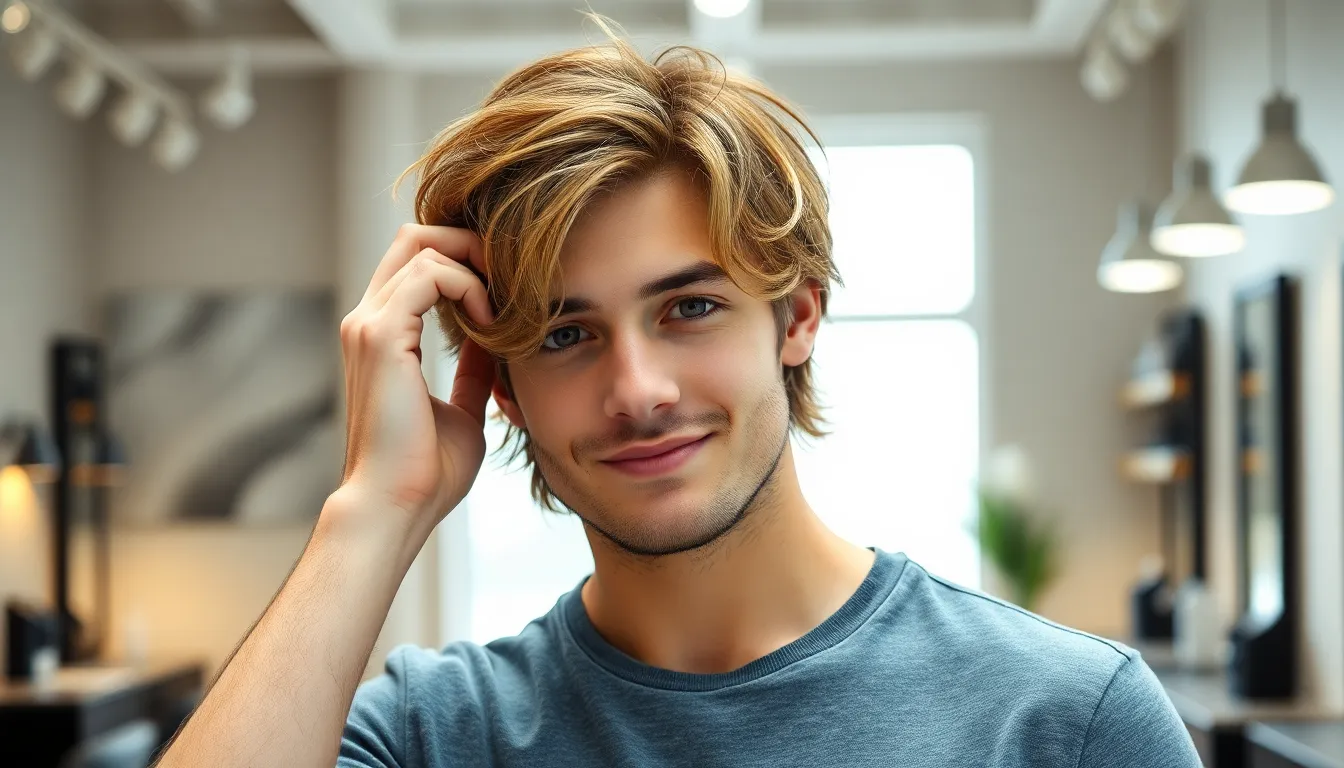
Balayage highlights offer the perfect solution for men seeking dimension without obvious maintenance lines. This French technique creates seamless color transitions that grow out beautifully.
Sun-Kissed Balayage Technique
Sun-kissed balayage creates natural looking highlights that mimic summer hair lightening. Colorists paint highlights directly onto dry hair using a sweeping motion that concentrates lighter tones around the face and hair ends. We recommend starting with honey or caramel tones that are 2-3 shades lighter than your base color for the most natural effect.
Professional application typically takes 2-3 hours and costs between $150-300. Your stylist will focus the lightest pieces around your hairline, temples, and crown where sun naturally hits first. The technique works exceptionally well on brown and dark blonde hair types, creating effortless dimension that requires touch-ups every 12-16 weeks.
Maintenance becomes simpler since balayage grows out without harsh regrowth lines. You can extend time between salon visits by using color-safe shampoos and deep conditioning treatments weekly. The gradual fade mimics natural hair lightening patterns, making it ideal for busy professionals who want style without constant upkeep.
Ombre Highlights Style
Ombre highlights create a gradient effect from dark roots to lighter ends. This technique concentrates the lightest color in the bottom third of your hair while keeping natural color at the roots. We suggest choosing end colors that are 3-4 shades lighter than your natural base for dramatic contrast.
Popular ombre combinations include dark brown to golden blonde or black to ash blonde. Your colorist will blend multiple tones throughout the mid-lengths to create seamless transitions. The process requires bleaching and toning sessions that can take 3-4 hours for optimal results.
Root maintenance stays minimal since ombre intentionally keeps natural color at the scalp. You’ll need color refreshing every 8-10 weeks to maintain vibrancy in the lighter sections. This style works particularly well for men with longer hairstyles where the gradient effect becomes more visible.
Hand-Painted Color Placement
Hand-painted highlights allow for completely customized color placement based on your facial features and hair texture. Stylists use brushes and combs to strategically place lighter pieces where they’ll enhance your bone structure and complement your skin tone. This personalized approach ensures no two balayage applications look identical.
Placement strategies focus on areas that naturally catch light during daily activities. Colorists typically concentrate highlights around the hairline, part lines, and pieces that frame your face. The technique adapts to different hair lengths, from short crops to longer styles, creating dimension that moves naturally with your hair.
Color mapping before application ensures optimal results for your exact hair goals. Your stylist will section your hair and mark placement areas to achieve balanced highlights throughout. This methodical approach prevents over-processing and creates the most flattering color distribution for your individual features and lifestyle needs.
Bold Chunky Highlights for Statement Style
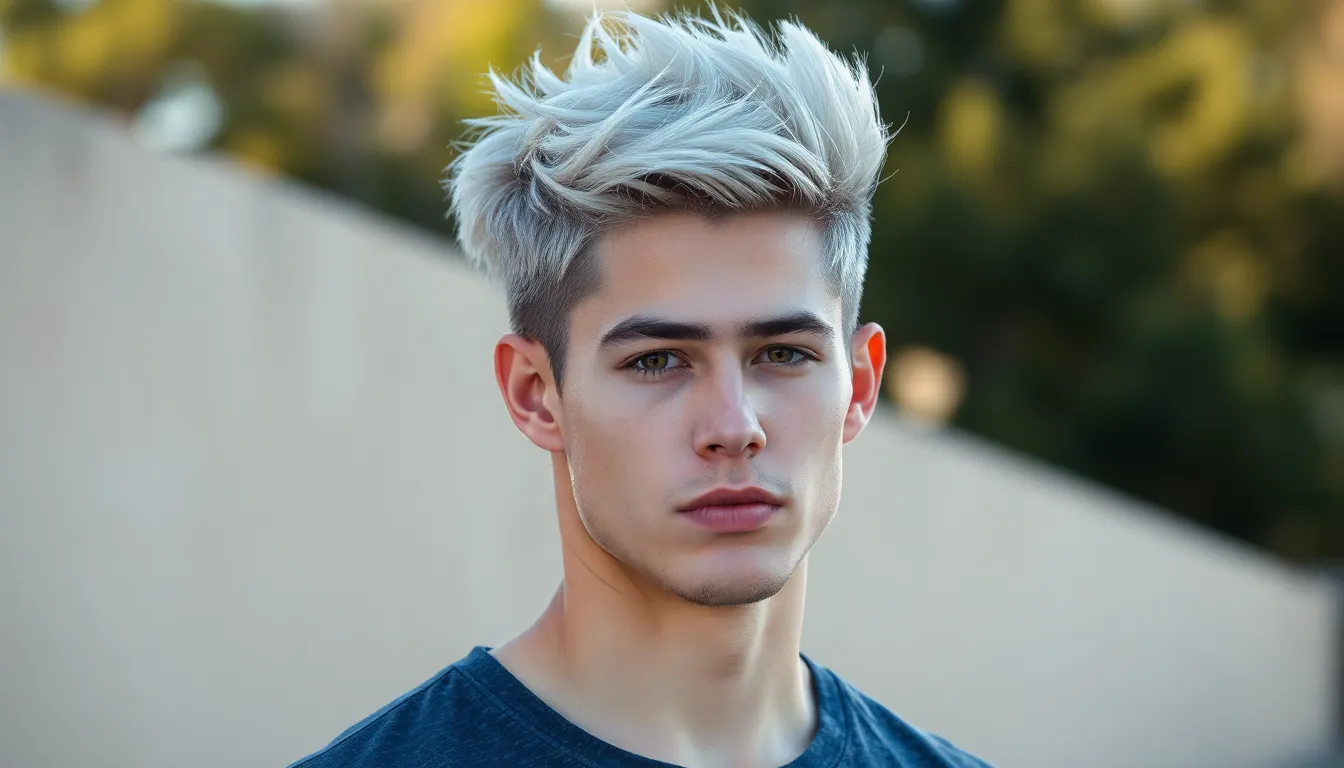
Chunky highlights represent the boldest approach to men’s hair coloring, creating dramatic visual impact through thick, defined sections of contrasting color. These statement pieces work best for men who want their hair to command attention and express their individual style.
Platinum Blonde Chunks
Platinum blonde chunks deliver maximum contrast against darker base colors, creating the most striking visual effect in men’s highlighting. We recommend choosing sections that are 1 to 2 inches wide to achieve the signature chunky appearance without overwhelming your natural hair color. Professional colorists typically place these bold highlights around the crown and front sections where they’ll catch the most light.
Achieving true platinum requires multiple bleaching sessions, especially for men with naturally dark hair. The process involves lifting your hair to a level 9 or 10 before applying toner to eliminate yellow undertones. Maintenance becomes crucial with platinum chunks since regrowth shows dramatically against the light color, requiring touch ups every 4 to 6 weeks.
Styling platinum chunks works best with textured cuts that allow the highlights to move naturally. Products like matte paste or sea salt spray enhance the contrast while keeping the overall look modern and effortless.
Contrasting Dark and Light Streaks
Contrasting streaks combine both dark lowlights and bright highlights to create multi dimensional depth in men’s hair. This technique works particularly well for guys with medium brown base colors who want dramatic change without committing to all over bleaching. We suggest alternating thick sections of highlights with strategic lowlights to create a striped or zebra like effect.
Popular color combinations include caramel highlights with chocolate brown lowlights, or ash blonde streaks paired with espresso tones. Each contrasting section should measure approximately 1 inch wide to maintain the chunky aesthetic while ensuring the colors complement rather than clash.
Application requires precise sectioning to achieve even distribution of both light and dark tones. Professional colorists often use the weaving technique to create clean separation between contrasting colors. The result produces a bold geometric pattern that photographs beautifully under various lighting conditions.
Face-Framing Highlights
Face framing highlights concentrate chunky sections around the hairline and temple areas to draw attention to facial features and create a halo effect. These strategic placements work especially well for men with square or round face shapes, as the light colors create vertical lines that elongate the appearance. We position these highlights to start about 2 inches from the hairline and extend through the front sections.
Choosing the right shade for face framing chunks depends on your skin undertones and eye color. Warm skin tones benefit from golden or honey blonde chunks, while cooler complexions look striking with ash or platinum sections. The key lies in selecting colors that enhance rather than wash out your natural features.
Maintenance for face framing highlights requires careful attention since these sections receive the most visual focus. Root touch ups become necessary every 6 to 8 weeks to maintain the crisp contrast between your natural color and the highlighted sections. Regular toning treatments also help preserve the desired shade and prevent brassiness from developing.
Subtle Lowlights and Highlights Combination
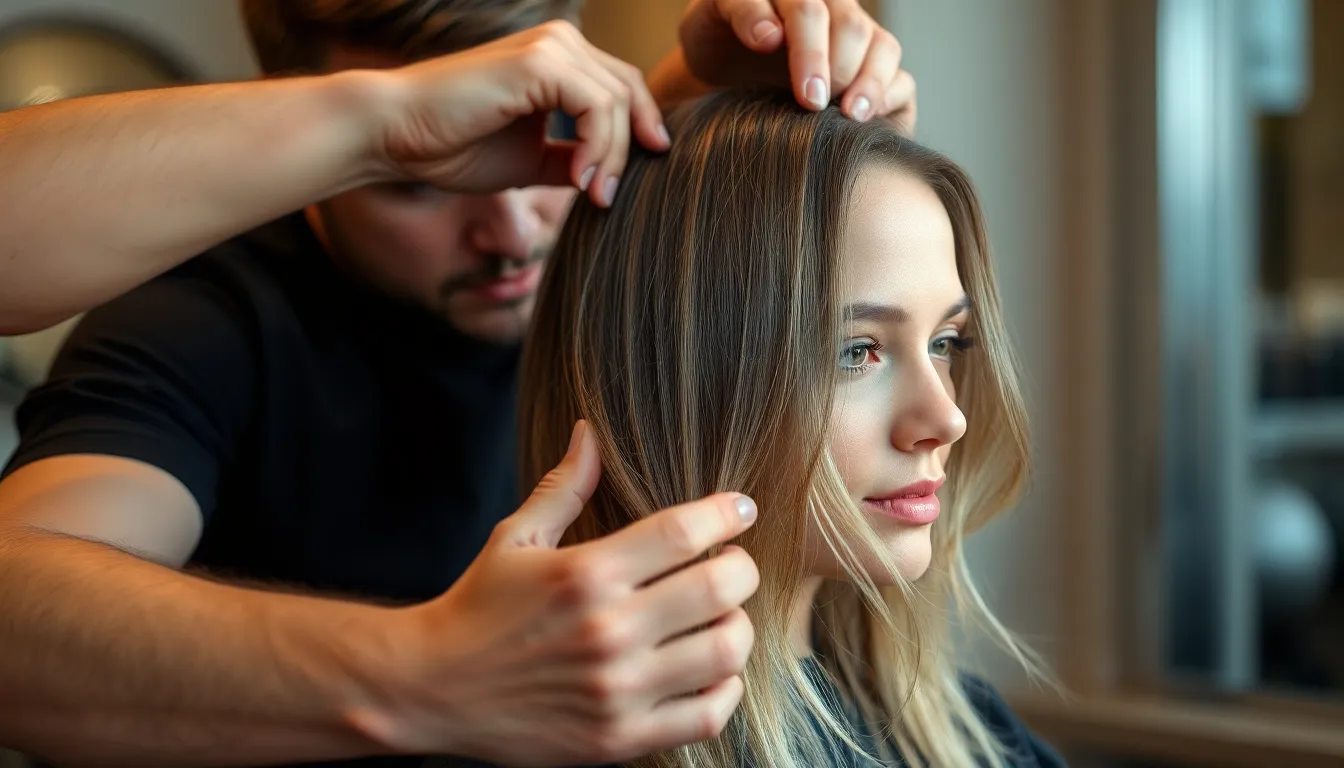
Combining lowlights with highlights creates the most natural looking color transformation for men’s hair. This sophisticated approach adds depth and dimension without the stark contrast of single tone highlighting.
Dimensional Color Blending
Dimensional color blending uses both lighter and darker tones to mimic natural hair variation. Professional colorists weave lowlights 1-2 shades darker than your base color alongside highlights 2-3 levels lighter for seamless integration.
Strategic placement of contrasting tones creates movement throughout your hair texture. The darker lowlights add richness to shadow areas while lighter highlights catch natural and artificial light sources.
Balayage application works particularly well for dimensional blending since it allows precise control over color saturation. Your stylist can paint lowlights in deeper sections and highlights on surface layers for maximum visual impact.
Color transitions appear more gradual when multiple tones work together rather than single shade applications. This technique prevents the “striped” appearance that sometimes occurs with traditional foil methods.
Natural Looking Depth
Natural looking depth emerges when lowlights fill in gaps between highlighted sections effectively. The darker tones create shadows that make highlights appear more vibrant without increasing their actual lightness level.
Root areas benefit significantly from lowlight integration since they tend to appear flat without dimensional color variation. Strategic lowlight placement near the scalp creates the illusion of thicker hair density.
Seasonal color adjustments become easier with established lowlight and highlight patterns already in place. Your colorist can refresh either the light or dark tones independently based on your desired seasonal look.
Face framing combinations work exceptionally well when lowlights define the perimeter while highlights brighten the interior sections. This creates natural contouring that enhances your facial structure without obvious color blocking.
Professional Color Matching
Professional color matching ensures lowlights and highlights complement your natural undertones rather than fighting against them. Warm skin tones pair best with golden lowlights and honey highlights for cohesive color harmony.
Cool undertones require ash based lowlights combined with platinum or icy blonde highlights for balanced results. Your colorist will assess your natural pigmentation before selecting the appropriate color family.
Maintenance schedules differ for combination coloring since lowlights fade slower than highlights typically do. Most clients require highlight touch ups every 8-10 weeks while lowlights can last 12-14 weeks between appointments.
Color correction becomes more complex with multiple tones present so choosing an experienced colorist is essential for optimal results. Improper lowlight application can create muddy or uneven color distribution that’s difficult to fix.
Maintenance Tips for Mens Highlights
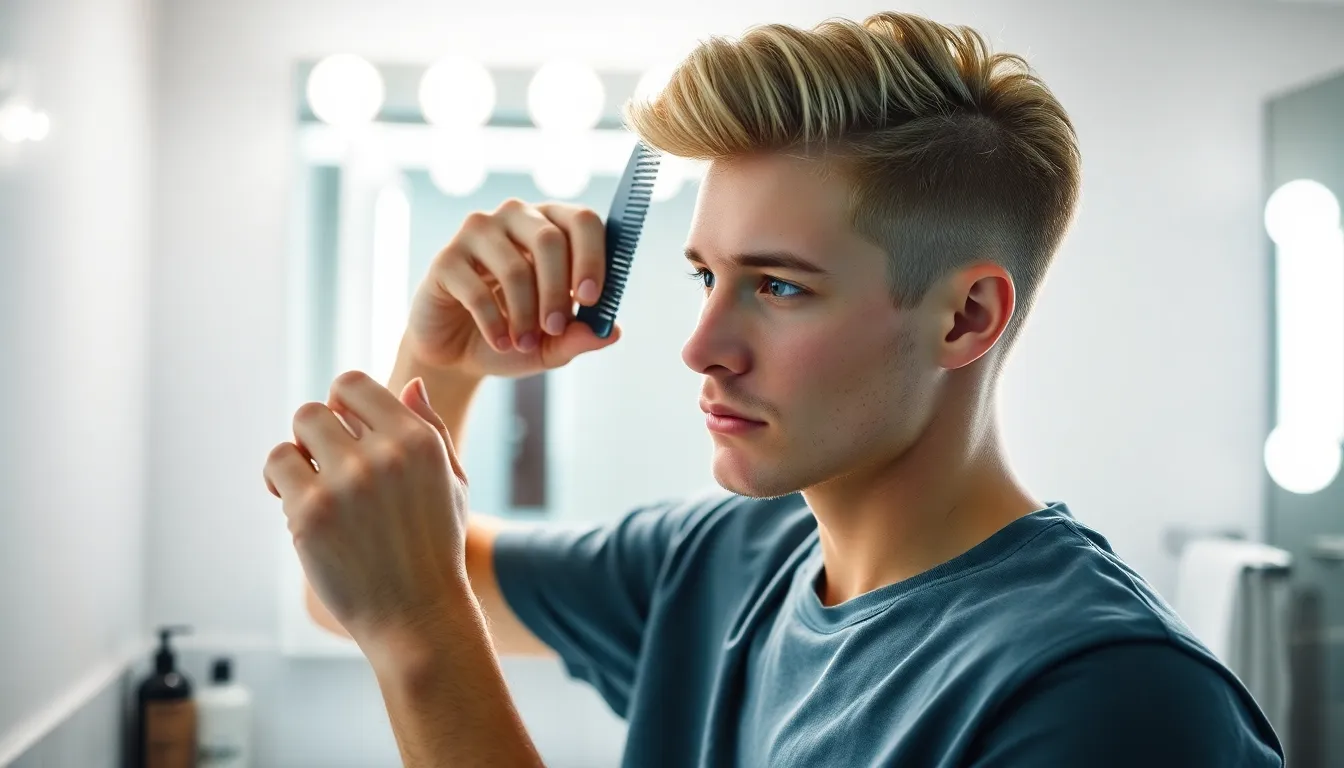
Proper maintenance ensures your highlights stay vibrant and healthy between salon visits. We’ll help you establish routines that protect your investment and extend your color’s lifespan.
Weekly Hair Care Routine
Deep conditioning treatments become essential when you have highlights since bleached strands need extra moisture. Apply a protein-rich mask once weekly to repair damaged cuticles and prevent breakage in highlighted sections.
Gentle brushing techniques protect fragile highlighted hair from unnecessary stress and snapping. Use a wide-tooth comb on damp hair and start detangling from the ends working upward to minimize pulling on processed strands.
Heat protection sprays should become part of your daily styling routine since highlighted hair is more susceptible to heat damage. Apply thermal protectant before using blow dryers or styling tools to shield your color from fading.
Cool water rinses help seal the hair cuticle and lock in color molecules during your final rinse. Hot water opens the cuticle causing color to wash out faster while cool temperatures preserve vibrancy for weeks longer.
Color-Safe Shampoo Selection
Sulfate-free formulas prevent harsh stripping of color molecules that cause highlights to fade prematurely. Look for shampoos labeled “color-safe” or “sulfate-free” as they clean gently without removing artificial pigments from bleached sections.
Purple shampoos neutralize yellow and brassy tones that develop in blonde highlights over time. Use purple-tinted cleansers 1-2 times per week to maintain cool platinum and ash tones while regular shampoo handles daily cleansing needs.
pH-balanced products maintain the hair’s natural acidity level which keeps the cuticle sealed and color locked inside. Products with a pH between 4.5-5.5 work best for highlighted hair since they won’t cause swelling that leads to color loss.
Moisturizing ingredients like argan oil and keratin help replenish what bleaching removes from your hair structure. Choose shampoos containing these restorative elements to maintain softness and prevent the dry brittle texture common in processed hair.
Touch-Up Scheduling
Root maintenance typically requires professional attention every 8-12 weeks depending on your hair growth rate and highlight placement. Visible regrowth becomes noticeable around week 6 but waiting until week 8 prevents over-processing from too-frequent bleaching sessions.
Seasonal adjustments may require different timing since summer sun exposure can lighten highlights naturally while winter indoor heating can cause fading. Schedule touch-ups every 10 weeks in summer and every 8 weeks in winter to maintain consistent color depth.
Growth pattern tracking helps determine your personal maintenance schedule since everyone’s hair grows at different rates. Take photos monthly to document how quickly your natural color appears at the roots and adjust appointment timing accordingly.
Budget planning for highlight maintenance should include both root touch-ups and occasional full refresh services. Plan for 4-6 appointments yearly with root services costing less than complete re-highlighting which may be needed annually for optimal results.
Best Hair Types for Mens Highlights
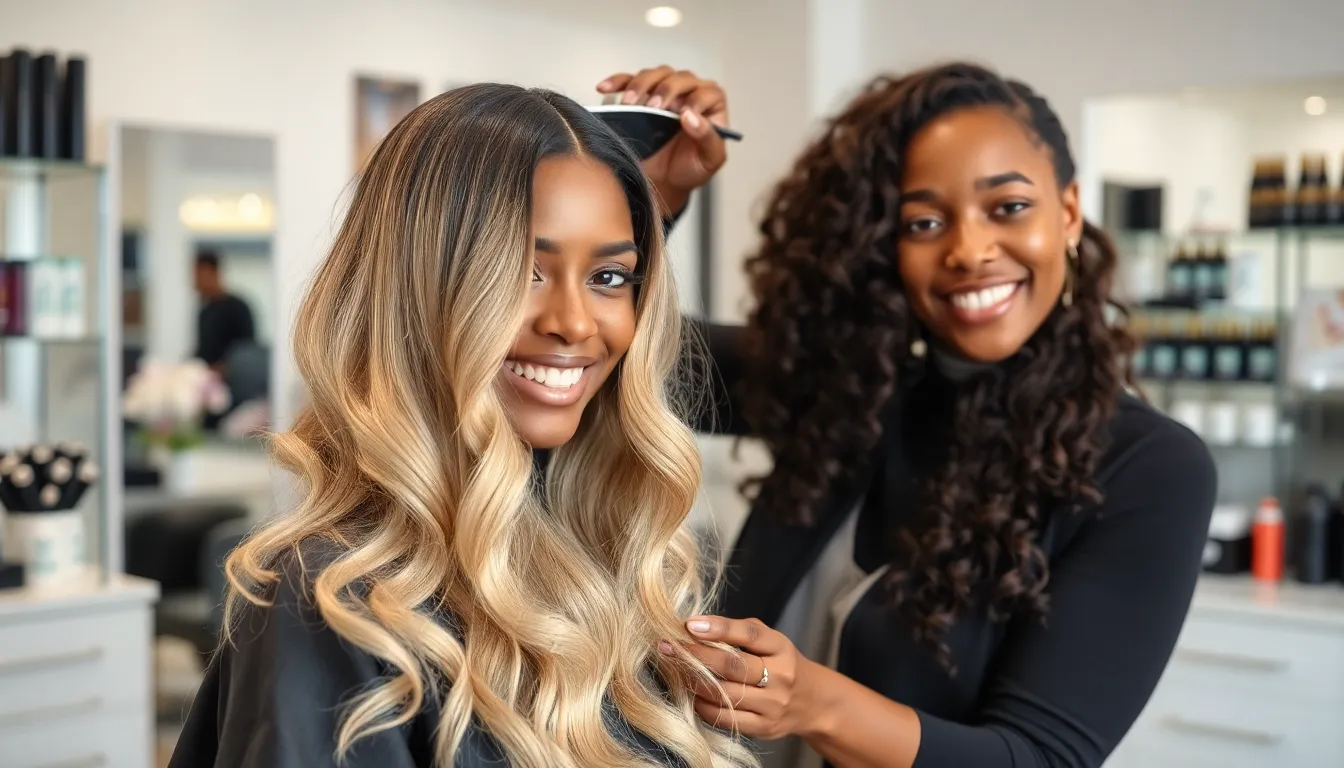
Different hair textures require specialized highlighting approaches to achieve optimal results. We’ve analyzed the most effective techniques for each hair type to help you choose the right highlighting method.
Thick Hair Considerations
Thick hair provides the perfect canvas for dramatic highlighting effects due to its natural volume and density. We recommend using traditional foil techniques for thick hair because they offer precise control over color placement and saturation levels. Sectioning becomes crucial with dense hair textures, requiring colorists to create smaller subsections measuring approximately 1/4 to 1/2 inch wide for even color distribution.
Processing time typically extends 10 to 15 minutes longer for thick hair compared to finer textures. Bleach penetration requires extra attention since dense hair strands need more time to lift properly. Multiple highlighting sessions often work better than attempting dramatic lightening in one appointment, especially when going from dark brown to platinum shades.
Heavy hair responds exceptionally well to chunky highlight techniques because the thickness prevents the color from appearing too stark. Face framing highlights work particularly effectively on thick hair since the volume naturally supports bold color contrasts around the hairline.
Fine Hair Strategies
Fine hair requires gentle highlighting approaches to prevent damage while maximizing visual impact. We suggest using lower volume developers (20 volume instead of 30 or 40) to protect delicate hair strands from excessive lifting. Balayage techniques work exceptionally well for fine hair because they create the illusion of thickness through strategic color placement.
Placement becomes critical with fine hair since fewer strands mean each highlighted section carries more visual weight. Colorists should focus on creating multiple thin highlights rather than fewer thick ones to avoid a chunky appearance. Processing time needs careful monitoring since fine hair lifts faster and can become overprocessed within 15 to 20 minutes.
Toning becomes essential for fine highlighted hair because the delicate strands show brassiness more readily than thicker textures. Purple shampoos and weekly toning treatments help maintain color integrity between salon visits. Root touch ups require more frequent scheduling every 6 to 8 weeks due to faster visible regrowth on fine hair textures.
Curly Hair Highlighting Techniques
Curly hair demands specialized highlighting methods that work with the natural curl pattern rather than against it. We recommend dry cutting and dry highlighting techniques because wet curly hair stretches and doesn’t reveal its true shape or movement. Balayage emerges as the top choice for curls since it follows the hair’s natural flow and prevents harsh demarcation lines.
Sectioning requires following the curl clusters rather than creating straight horizontal sections. Colorists should paint highlights onto the exterior of each curl to catch light naturally as the hair moves. Interior highlighting often gets lost within tight curl patterns and wastes product without adding visual benefit.
Processing considerations include longer development times since curly hair’s structure can impede chemical penetration. Strand testing becomes mandatory to determine proper timing and avoid over processing textured hair. Heat application through processing caps can help ensure even color distribution throughout the curl structure.
Maintenance schedules extend longer for curly highlighted hair since the natural texture helps camouflage regrowth better than straight styles. Touch ups every 10 to 12 weeks typically suffice for most curly highlighting techniques.
Professional Salon vs DIY Highlighting
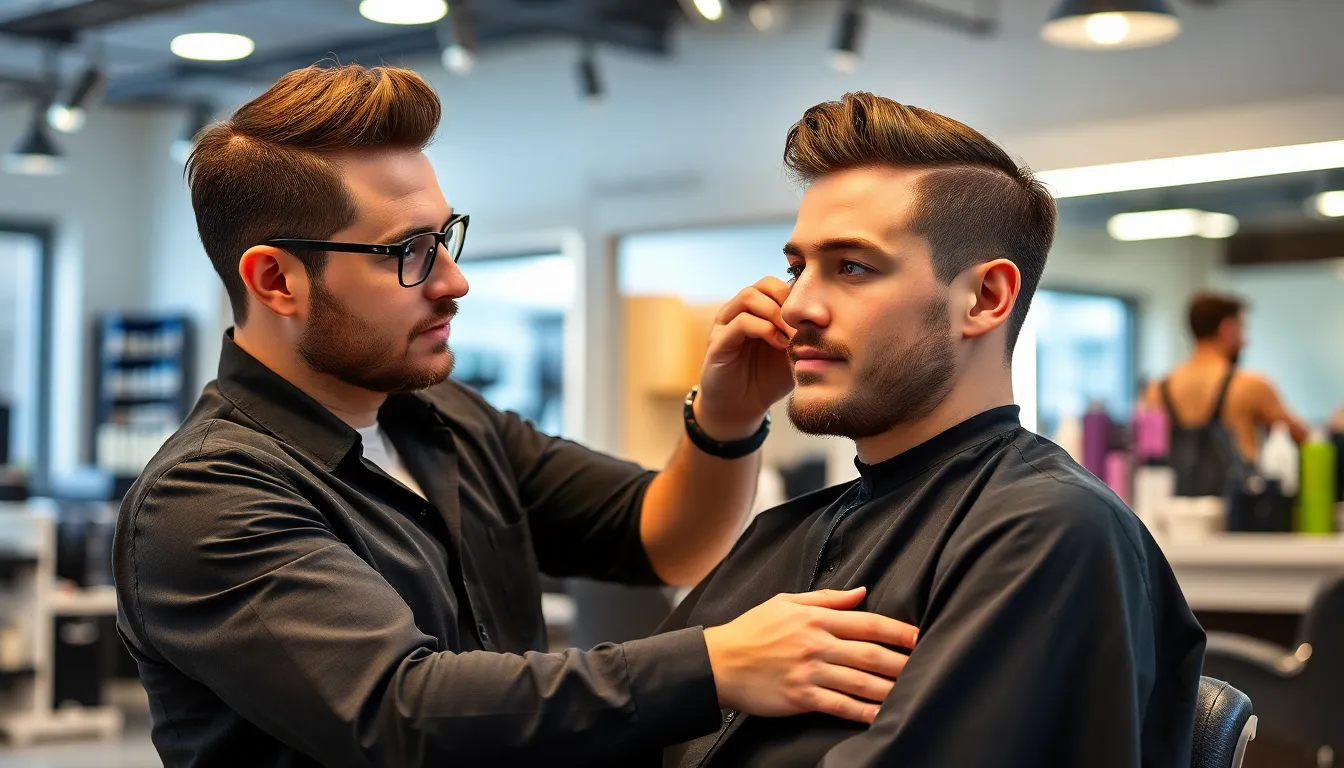
Choosing between professional salon services and DIY highlighting kits determines the quality, safety, and longevity of your color results.
Salon Benefits and Expertise
Professional colorists bring years of training and experience to men’s highlighting services. We’ve observed that licensed stylists can accurately assess your hair’s condition, porosity levels, and natural undertones before selecting the appropriate highlighting technique. Expert colorists use professional grade products with 20-40 volume developers that aren’t available in retail kits.
Customized color formulations allow salon professionals to create highlights specifically customized to your skin tone and lifestyle preferences. Professional services include strand testing to preview results and prevent unwanted color outcomes. Advanced techniques like balayage require precise hand painting skills that take years to master.
Salon highlighting includes professional aftercare guidance and product recommendations for maintaining your color investment. We’ve found that professional results typically last 8-12 weeks compared to 4-6 weeks for DIY attempts. Damage prevention becomes paramount when professionals monitor processing times and use bond building treatments during the highlighting process.
At-Home Highlighting Kits
Retail highlighting kits offer convenience and immediate availability for men wanting quick color changes. Most drugstore kits contain lower volume developers (10-20 volume) that provide safer but less dramatic results. Popular brands like L’Oreal Men Expert and Just For Men offer highlighting caps with pre-mixed formulas designed for beginner use.
DIY kits typically include basic tools like highlighting caps, hooks, and single shade options rather than customizable color blends. We’ve noticed that home highlighting often results in uneven color placement due to difficulty reaching back sections and maintaining consistent timing. Processing times in DIY kits are predetermined and can’t be adjusted for individual hair types or desired intensity levels.
Strand testing becomes crucial with at-home kits since you can’t rely on professional assessment of your hair’s condition. Most retail formulas contain higher levels of ammonia to ensure color penetration, which can increase damage risk without proper monitoring.
Cost Comparison Analysis
| Service Type | Initial Cost | Touch-up Frequency | Annual Investment |
|---|---|---|---|
| Professional Salon | $80-200 | Every 8-12 weeks | $320-800 |
| DIY Highlighting Kit | $8-25 | Every 4-6 weeks | $70-220 |
| Color Correction | $150-300 | As needed | Variable |
Professional highlighting services range from $80-200 depending on technique complexity and salon location. We’ve calculated that annual maintenance costs for professional highlights average $320-800 including regular touch-ups and color refreshing treatments.
DIY highlighting kits cost $8-25 per application but require more frequent touch-ups due to faster fading. Home highlighting annual costs typically range from $70-220 but don’t include potential color correction expenses. Color correction services cost $150-300 when DIY attempts require professional fixing.
Investment value differs significantly when considering longevity and hair health factors. Professional highlights maintain vibrancy longer and cause less cumulative damage, potentially saving money on reconstructive treatments. We’ve observed that men who start with professional services and maintain with occasional DIY touch-ups achieve the best cost-to-quality ratio.
Popular Mens Highlights Color Trends
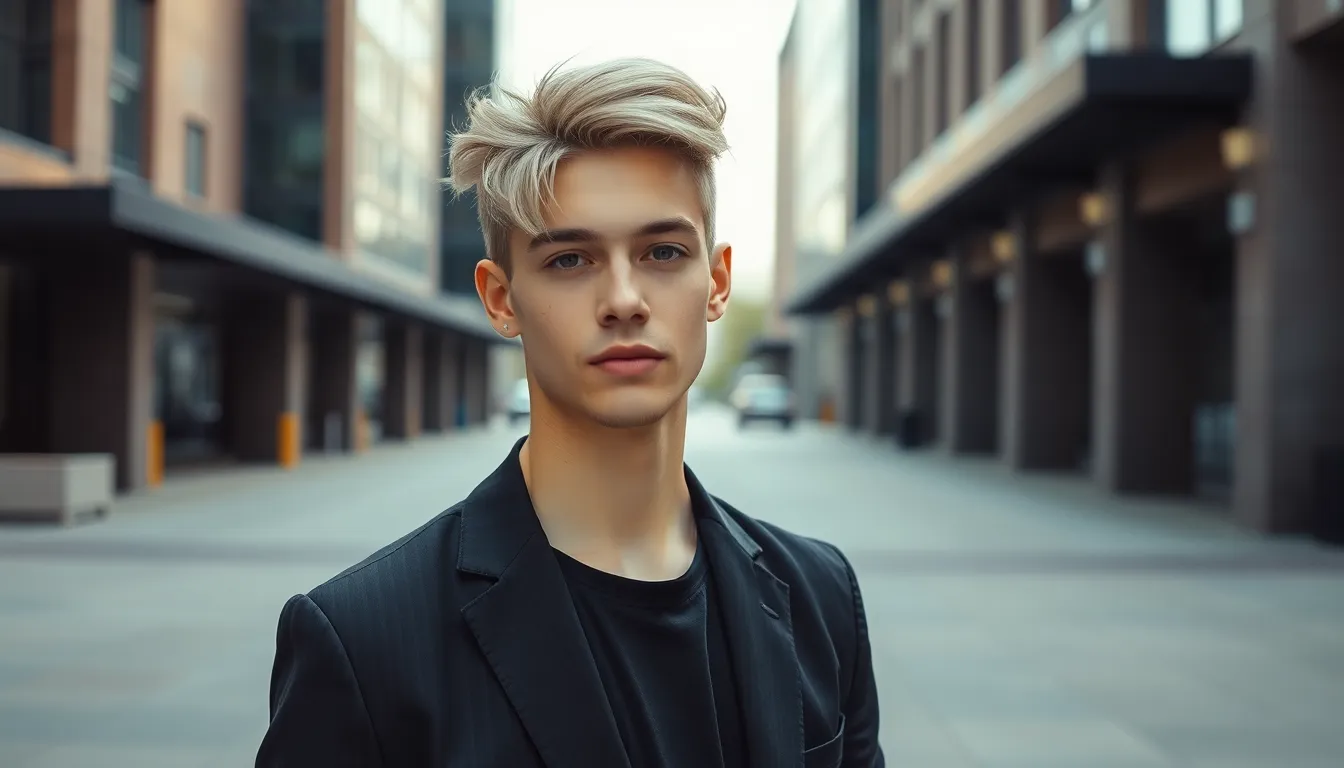
Today’s men’s highlight trends showcase sophisticated color choices that complement modern masculine aesthetics while offering versatile styling options.
Ash Blonde Highlights
Ash blonde highlights create a cool, refined appearance that works exceptionally well with fair to medium skin tones. We recommend choosing ash shades that are 2 to 3 levels lighter than your natural base color for optimal contrast without appearing harsh. Professional colorists typically use toners with blue or purple undertones to neutralize any unwanted yellow or orange brassiness that can occur during the lightening process.
These highlights pair beautifully with dark brown or black base colors, creating a striking yet sophisticated look that’s perfect for professional environments. The cool undertones in ash blonde shades complement men with pink or neutral skin undertones particularly well. Maintenance requires purple shampoo usage twice weekly to preserve the ashy tone and prevent color from turning brassy.
Popular ash blonde variations include platinum ash, beige blonde, and mushroom blonde, each offering different intensity levels to match personal preferences and lifestyle requirements.
Silver and Gray Accents
Silver and gray accents represent one of the most contemporary trends in men’s highlighting, offering a distinguished appearance that works across all age groups. We’ve observed increasing demand for these metallic tones as they provide an edgy yet refined aesthetic that complements both casual and formal styling.
Achieving true silver highlights requires pre lightening hair to a level 9 or 10 blonde base before applying specialized silver toners. The process typically involves multiple sessions to reach the desired lightness without compromising hair integrity. Professional application ensures even color distribution and prevents patchy results that commonly occur with DIY attempts.
Gray accent highlights work particularly well as face framing pieces or strategic placement around the crown area. These accents create natural looking dimension that can effectively blend existing gray hair while adding modern flair. Maintenance involves using silver shampoo weekly and scheduling touch ups every 6 to 8 weeks to maintain vibrancy.
Men with cool skin undertones find silver highlights especially flattering, while those with warm undertones may prefer softer gray variations with slight beige undertones.
Creative Color Options
Creative color highlights allow men to express individuality through bold, unconventional choices that make powerful style statements. We’re seeing increased acceptance of vibrant hues like deep blues, forest greens, and burgundy accents in both professional and casual settings.
Fashion forward highlights include midnight blue streaks that appear almost black in dim lighting but reveal rich color depth in natural light. These subtle yet striking options work well for conservative environments while still offering creative expression. Deep forest green accents provide earthy sophistication that complements brown and black base colors beautifully.
Burgundy and wine colored highlights create warm, luxurious tones that work exceptionally well with darker skin tones and warm undertones. These rich colors add depth and dimension without appearing overly dramatic in professional settings. Application requires careful color placement to ensure natural integration with existing hair color.
Temporary creative options include chalk highlights and color depositing conditioners that allow experimentation without permanent commitment. These products typically last 3 to 6 washes and provide excellent opportunities to test bold colors before committing to permanent changes.
Professional colorists recommend starting with subtle creative accents before progressing to more dramatic statements, ensuring the final result aligns with lifestyle and maintenance preferences.
Celebrity Mens Highlights Inspiration
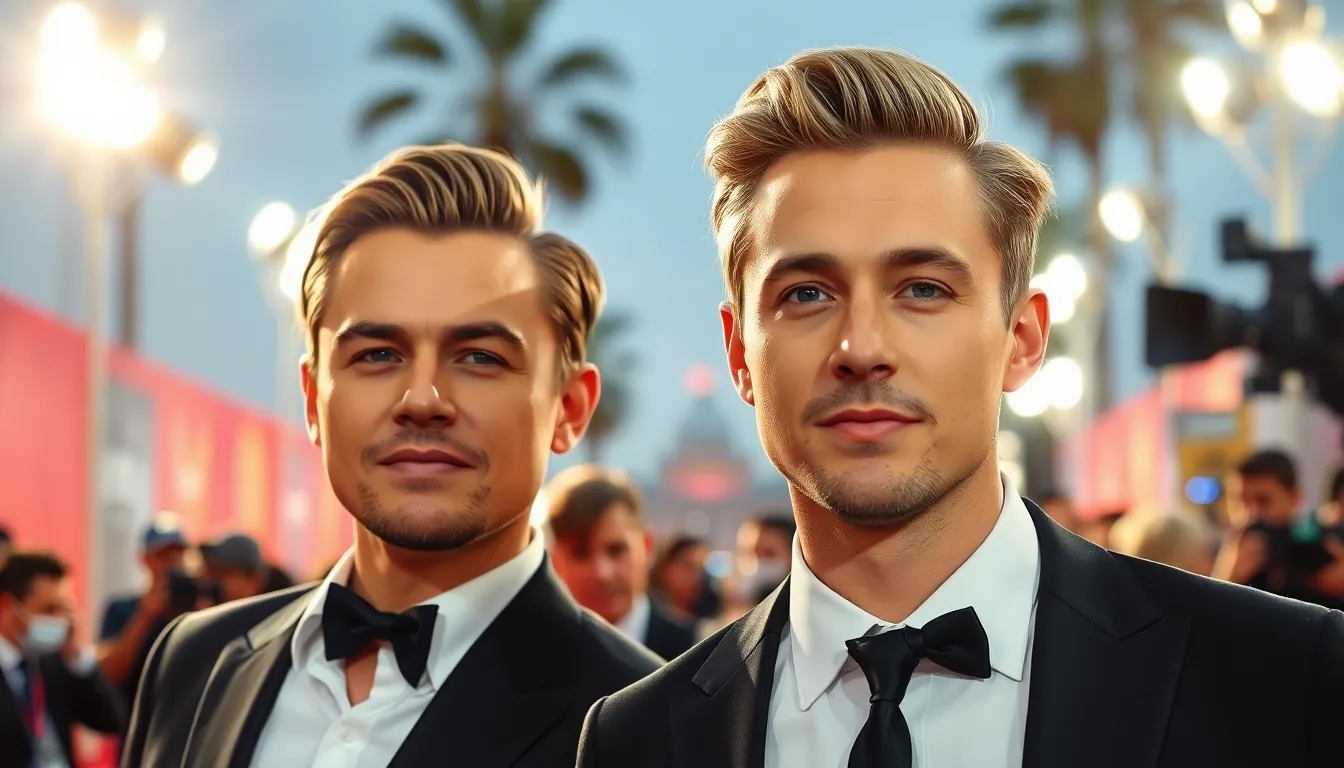
We’ve seen a dramatic shift in how male celebrities embrace highlights across entertainment and sports industries. These influential figures continue to set new standards for men’s hair color trends.
Hollywood Red Carpet Looks
Leonardo DiCaprio leads the way with his signature sun kissed blonde highlights that perfectly complement his sandy brown base color. His colorist strategically places lighter pieces around the face to create natural dimension that photographs beautifully under studio lighting.
Ryan Gosling showcases platinum blonde highlights in thick chunky sections that create bold contrast against his darker roots. This dramatic approach requires bleaching sessions every 6-8 weeks to maintain the striking visual impact we see at premieres and award shows.
Brad Pitt demonstrates the versatility of caramel highlights woven throughout his natural brown hair using balayage techniques. His stylist creates seamless color transitions that appear effortless while adding warmth and movement to his overall look.
Chris Hemsworth opts for subtle ash blonde streaks that enhance his natural texture without overwhelming his masculine features. The highlights are strategically placed to catch light during red carpet appearances while maintaining a sophisticated professional appearance.
Athlete Hair Trends
Cristiano Ronaldo frequently experiments with platinum blonde highlights that create maximum contrast against his dark hair. His bold color choices require professional maintenance every 4-6 weeks to prevent brassiness and maintain the crisp definition between light and dark sections.
Odell Beckham Jr pushes creative boundaries with deep blue highlights mixed with traditional blonde streaks for a multi dimensional effect. This athletic trendsetter demonstrates how men can incorporate unconventional colors while maintaining their competitive edge.
Neymar showcases blonde balayage highlights that transition naturally from his dark roots to lighter ends. His colorist uses hand painted techniques to create movement that looks ever-changing both on and off the field.
Lewis Hamilton rotates between silver highlights and purple accents that reflect his bold personality and fashion forward approach. These temporary color options allow athletes to express creativity without long term commitment during competitive seasons.
Social Media Influencer Styles
James Charles popularizes face framing highlights in various shades from honey blonde to rose gold that enhance facial features for camera work. His techniques demonstrate how strategic highlight placement can improve lighting and definition in video content.
Noah Beck maintains subtle brown highlights that add dimension without appearing overly styled for his lifestyle content. These natural looking streaks appeal to younger audiences seeking achievable everyday looks.
Bretman Rock experiments with bold chunky highlights in platinum and silver tones that create viral worthy transformations. His dramatic before and after content shows the impact professional highlighting can have on personal style.
David Dobrik keeps his highlights minimal with golden blonde pieces that complement his casual content style. This approach proves that men’s highlights can enhance natural features without requiring high maintenance routines.
Conclusion
Men’s highlights have evolved from a niche trend to a mainstream grooming essential that offers endless possibilities for personal expression. Whether you’re drawn to subtle balayage or bold chunky streaks the key lies in choosing techniques and colors that complement your lifestyle and hair type.
We’ve seen how proper maintenance and professional application make all the difference in achieving long-lasting vibrant results. With celebrity influences and social media driving innovation in men’s hair color the future looks bright for those ready to experiment.
Your hair is your canvas and highlights provide the perfect opportunity to enhance your natural features while showcasing your personality. Take the leap and discover how the right highlighting technique can transform not just your look but your confidence too.
Frequently Asked Questions
What are men’s highlights and how do they work?
Men’s highlights involve strategically lightening select strands of hair to create contrast and depth. This technique enhances your overall look without completely changing your base hair color. Professional colorists use various methods like foils, balayage, or hand-painting to achieve natural-looking dimension that complements your features and skin tone.
How often do men’s highlights need maintenance?
Well-placed highlights typically require professional touch-ups every 8 to 12 weeks, depending on your hair growth rate and the technique used. Balayage highlights generally need less frequent maintenance than traditional foil highlights. Regular deep conditioning treatments and color-safe shampoos help extend the life of your highlights between salon visits.
Are highlights suitable for all men’s hair types?
Yes, highlights can work for all hair types with proper technique. Thick hair benefits from traditional foil methods for precise placement, while fine hair works best with lower volume developers and balayage. Curly hair requires specialized dry cutting and highlighting techniques that work with natural curl patterns for optimal results.
What’s the difference between balayage and foil highlights?
Foil highlights create more dramatic, defined contrast using traditional sectioning methods, while balayage involves hand-painting color for a natural, sun-kissed appearance. Balayage offers seamless color transitions with less maintenance, making it ideal for busy professionals. Foil highlights provide more precise color placement and stronger contrast.
Can highlights help cover gray hair in men?
Yes, highlights are excellent for blending gray hair naturally. Strategic highlight placement can camouflage gray strands while adding dimension to your overall look. The technique creates a gradual color transition that makes gray less noticeable, offering a low-maintenance solution for men beginning to experience gray hair.
Should I get highlights done professionally or use DIY kits?
Professional salon services are recommended for best results. Colorists provide customized color formulations, proper technique, and can assess your hair condition. While DIY kits are cheaper, professional highlights last longer, look more natural, and reduce the risk of damage or uneven color placement.
What highlight colors work best for different skin tones?
Warm skin tones pair well with golden, honey, and caramel highlights, while cool skin tones suit ash blonde, platinum, and silver accents. Professional colorists can match highlights to your natural undertones for the most flattering results. Consider your lifestyle and maintenance preferences when choosing between subtle or bold color options.
How much do men’s highlights typically cost?
Professional highlights range from $80-300 depending on technique, salon location, and hair length. While DIY kits cost $10-30, professional services offer better longevity and hair health. Consider the long-term value of professional application, which typically lasts longer and requires fewer corrections than at-home attempts.

